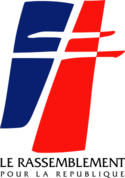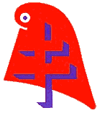Rally for the Republic facts for kids
Quick facts for kids
Rally for the Republic
Rassemblement pour la République
|
|
|---|---|
 |
|
| Abbreviation | RPR |
| President | Michèle Alliot-Marie (last) |
| Founder | Jacques Chirac |
| Founded | 5 December 1976 |
| Dissolved | 21 September 2002 |
| Preceded by | Union of Democrats for the Republic |
| Merged into | Union for a Popular Movement |
| Ideology |
|
| Political position | Centre-right to right-wing |
| European affiliation | European People's Party (1999–2002) |
| International affiliation | International Democrat Union |
| European Parliament group | EPD (1976–84) EDA (1984–95) UFE (1995–99) EPP-ED (1999–2002) |
| Colours | |
The Rally for the Republic (RPR) was a big political party in France. It was known for following the ideas of Charles de Gaulle, a famous French leader. The RPR was also a conservative party, meaning it generally supported traditional values and less government control in some areas.
Jacques Chirac started the RPR in 1976. It grew out of an older party called the Union of Democrats for the Republic. For many years, the RPR was one of the two main political parties in France, along with the Socialist Party. In 2002, the RPR joined with other groups to form a new, larger party called the Union for a Popular Movement (UMP).
Contents
The RPR's Early Years (1976–1981)
In 1974, Valéry Giscard d'Estaing became the President of France. He was the first president since 1958 who was not from the Gaullist movement. However, the Gaullist party was still strong in parliament. Jacques Chirac became the Prime Minister.
Chirac left his role as Prime Minister in 1976. In December of that year, he created the RPR. His goal was to bring back the strong influence of Gaullist ideas in French politics.
The RPR supported the government but also criticized President Giscard d'Estaing. In 1977, Chirac won the election to become Mayor of Paris. This was a big win for the RPR. Another group, the Union for French Democracy (UDF), also wanted to lead the right-wing parties. This led to a friendly competition between the RPR and UDF.
Before the 1979 European Parliament election, Chirac wrote something called the Call of Cochin. In it, he said that some people were putting European interests before France's own independence. This was aimed at President Giscard d'Estaing.
In the 1981 presidential election, Chirac ran against Giscard d'Estaing. Chirac did not win the first round of voting. He did not openly tell his supporters to vote for Giscard d'Estaing in the second round. Many people expected the RPR to work for Giscard d'Estaing's defeat.

Changes and Challenges (1981–1995)
After 1981, the RPR strongly opposed the policies of the Socialist President François Mitterrand. The RPR disagreed with the government taking over many private companies.
The RPR started to change its ideas. They were impressed by leaders like Ronald Reagan in the United States and Margaret Thatcher in the United Kingdom. These leaders believed in less government control over the economy. The RPR began to support more economic freedom and continued to support building a united Europe.
These new ideas helped the RPR and the UDF work together. They ran on a common list in the 1984 European Parliament election. They also created a plan to win the 1986 legislative election, which they did.
However, a rivalry grew between Jacques Chirac and Raymond Barre for leadership of the right-wing parties. Also, a new far-right party, the National Front, started to gain support. The RPR was divided on whether to work with this party.
In 1986, Chirac became Prime Minister again. He worked with President Mitterrand, which was called "cohabitation." Chirac's government sold many public companies and removed a tax on wealth. His Interior Minister, Charles Pasqua, made rules to limit immigration.
Chirac ran for president again in 1988 but lost to Mitterrand. While the RPR was in opposition, some younger politicians wanted to update the party. Some, like Charles Pasqua and Philippe Séguin, felt that Chirac was moving too far from the original Gaullist ideas. They tried to take over the RPR leadership in 1990 but did not succeed.
The party was divided again in 1992 over a vote on the Maastricht Treaty. This treaty was about creating a closer European Union. Chirac voted "yes," but Séguin and Pasqua campaigned for "no."
In 1993, the RPR and UDF won the legislative election. Chirac decided not to be Prime Minister again. Instead, Edouard Balladur took the role. Balladur had promised not to run for president in 1995. But polls showed he was very popular, and many right-wing politicians supported him. He decided to run against Chirac.
The main competition in the 1995 presidential election was between Balladur and Chirac. Balladur offered a plan for more economic freedom. Chirac focused on reducing social inequality and won the election.
The RPR as the Presidential Party (1995–2002)
After becoming President, Jacques Chirac chose Alain Juppé as his Prime Minister. Many people who had supported Balladur were not included in the new government.
In 1995, Prime Minister Juppé announced plans to change France's social welfare system. This led to big protests and made the government very unpopular. President Chirac then called for new elections in 1997, but his supporters lost. This meant he had to work with a left-wing government led by Lionel Jospin until 2002. This was another period of "cohabitation."
Philippe Séguin became the RPR leader after Juppé. However, he felt that President Chirac had too much control over the party. Séguin resigned in 1999. Around the same time, Charles Pasqua created a new party, the Rally for France (RPF), because he wanted to stick to the original Gaullist idea of a "Europe of nations." Pasqua's new party actually got more votes than the official RPR list led by Nicolas Sarkozy in the 1999 European elections.
Michèle Alliot-Marie was then elected as the RPR leader. The RPR also faced some issues regarding party funding. For example, there were questions about whether party employees were paid using city funds from Paris. The RPR lost control of the Paris mayor's office to the left in 2001.
Before the 2002 presidential election, Chirac's supporters from both the RPR and other groups formed a new association. After Chirac was re-elected president and his new party won the legislative election, this group became the Union for a Popular Movement (UMP). The RPR officially merged into the UMP in September 2002.
Presidential Election Results
The RPR's main candidate for president was Jacques Chirac.
| Election year | Candidate | 1st round votes | 1st round % | 1st round rank | 2nd round votes | 2nd round % | 2nd round rank | Result |
|---|---|---|---|---|---|---|---|---|
| 1981 | Jacques Chirac | 5,225,848 | 18.00 | 3rd | N/A | Lost | ||
| 1988 | Jacques Chirac | 6,063,514 | 19.94 | 2nd | 14,218,970 | 45.98 | 2nd | Lost |
| 1995 | Jacques Chirac | 6,348,375 | 20.84 | 2nd | 15,763,027 | 52.64 | 1st | Won |
| 2002 | Jacques Chirac | 5,665,855 | 19.88 | 1st | 25,537,956 | 82.21 | 1st | Won |
National Assembly Election Results
The RPR also participated in elections for the National Assembly, which is like the parliament.
| Election year | Leader | 1st round votes | 1st round % | 2nd round votes | 2nd round % | Seats won | Change in seats | Rank | Result |
|---|---|---|---|---|---|---|---|---|---|
| 1978 | Jacques Chirac | 6,462,462 | 22.62 | 6,651,756 | 26.11 | 150 | 1st | Government | |
| 1981 | Jacques Chirac | 5,231,269 | 20.81 | 4,174,302 | 22.35 | 85 | 2nd | Opposition | |
| 1986 | Jacques Chirac | 3,143,224 | 11.22 | - | - | 149 | 2nd | Government | |
| 1988 | Jacques Chirac | 4,687,047 | 19.19 | 4,688,493 | 23.09 | 126 | 3rd | Opposition | |
| 1993 | Jacques Chirac | 5,032,496 | 20.08 | 5,741,629 | 28.99 | 242 | 1st | Government | |
| 1997 | Alain Juppé | 3,983,257 | 15.65 | 5,714,354 | 22.46 | 139 | 2nd | Opposition |
European Parliament Election Results
The RPR also took part in elections for the European Parliament.
| Election year | Main Candidate | Votes | % | Seats | Change in seats | European Parliament Group |
|---|---|---|---|---|---|---|
| 1979 | Jacques Chirac | 3,301,980 | 16.31 | 15 | – | European Progressive Democrats |
| 1984 | Simone Veil (UDF) | 8,683,596 | 43.03 | 19 | European Democratic Alliance | |
| joint list with Union for French Democracy, which together won 41 seats. | ||||||
| 1989 | Valéry Giscard d'Estaing (PR) | 5,242,038 | 28.88 | 14 | European Democratic Alliance | |
| joint list with Union for French Democracy, which together won 26 seats. | ||||||
| 1994 | Dominique Baudis (CDS) | 4,985,574 | 25.58 | 14 | European Democratic Alliance
Union for Europe |
|
| joint list with Union for French Democracy, which together won 28 seats. | ||||||
| 1999 | Nicolas Sarkozy | 2,263,476 | 12.82 | 12 | European People's Party - European Democrats | |
Leaders of the RPR
Here are the people who led the RPR party over the years:
- Jacques Chirac, 1976–1994
- Alain Juppé, 1994–1997
- Philippe Séguin, 1997–1999
- Nicolas Sarkozy, 1999 (for a short time)
- Michèle Alliot-Marie, 1999–2002
- Serge Lepeltier, 2002 (for a short time)
Images for kids
See also
 In Spanish: Agrupación por la República para niños
In Spanish: Agrupación por la República para niños
- Gaullist Party
- Politics of France


